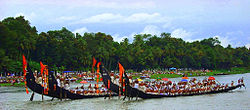| This article needs additional citations for verification. Please help improve this article by adding citations to reliable sources. Unsourced material may be challenged and removed. Find sources: "Chundan vallam" – news · newspapers · books · scholar · JSTOR (February 2015) (Learn how and when to remove this message) |
Chundan vallam ('beaked boat'), known outside Kerala as Kerala snake boats, are one of the icons of Kerala culture used in the Vallamkali or boat race.



Naval architecture
Constructed according to specifications taken from the Sthapatya Veda, an ancient treatise for the building of wooden boats, these boats vary from 100 to 138 feet in length. With the rear portion rising to a height of about 20 feet, and a long tapering front portion, it resembles a snake with its hood raised. Hulls are built of planks precisely 83 feet in length and six inches wide. The boats are a good example of ancient vishwakarma' prowess in naval architecture.
Traditions and customs
Traditionally each boat belongs to a village, and the villagers worship that boat like a deity. Only men are allowed to touch the boat, and to show respect they should be barefooted. To make the boat slippery while in the water and to reduce absorption of water and thereby reduce the resistance of the hull, it is oiled with a mixture of fish oil, the ash of coconut shells, and eggs. Repair work is done annually by the village carpenter.
Capacity and usage
Traditionally a boat will be commanded by a village leader (kaarnavan or karanaadhan) with first adanayampu, and under him there will be three main paddlers who control the movement of the boat with a 12-foot-long (3.7 m) main rudder-oar (adanayampu). Sitting two to a row along the length of the boat, there will be 64 paddlers, representing 64 art forms (or on occasion 128 paddlers). They row in rhythm of the vanchipattu ('boat song'). There will be around 25 singers in a row at the middle between the paddlers. In the middle of the second half of the boat is a platform for eight people to stand from where the cantor will lead the song. They represent the Ashtadikpalakas (Devas or gods who guard the eight directions).
See also
- Vallam kali
- Aranmula Boat Race
- Aranmula Kannadi
- Kallada Boat Race
- Dragon boat
- Waka
- Swan boat (racing)
- Nouka Baich
- Champakkulam chundan
References
- Desk, thREAD (4 September 2016). "The snake-boat charmers". The Hindu. ISSN 0971-751X. Retrieved 11 October 2020.
{{cite news}}:|last=has generic name (help) - "Chundan Vallam (India) - Traditional Sports". www.traditionalsports.org. Retrieved 11 October 2020.
| Canoeing and kayaking | |
|---|---|
| Main disciplines | |
| Olympics | |
| Other disciplines | |
| ICF championships |
|
| Recreation | |
| Modern boats | |
| Traditional boats | |
| Techniques | |
| Equipment | |
| Venues | |
| Competitions | |
| Festivals | |
| Governing bodies | |
| Other organisations | |
| Media | |
| Tourism in Kerala | |
|---|---|
| Organisations | |
| Informative articles | |
| Airports | |
| Amusement parks | |
| Archaeological sites | |
| Beaches |
|
| Boat races | |
| Caves | |
| Dams |
|
| Festivals |
|
| Forts | |
| Islands | |
| Lakes | |
| Lighthouses | |
| Mountains |
|
| Museums |
|
| Palaces |
|
| Ancient residences | |
| Waterfalls |
|
| Wildlife sanctuaries |
|
| Zoos | |
Categories: